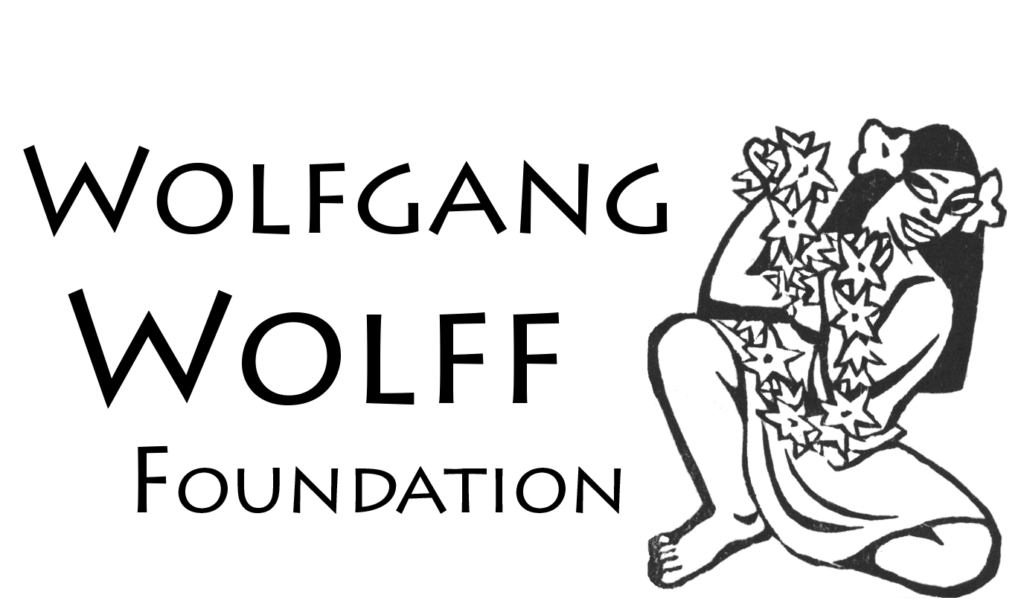Wolfgang Wolff · 1909 – 1994
Wolfgang Wolff was a prolific self-taught artist who worked in a variety of media: oils and acrylics, watercolors, pen and ink, woodcuts, jewelry, and textiles. His work reveals the influence of the Die Brucke school’s Max Pechstein, Ernst Kirchner, Karl Schmidt-Rottluff, amongst other expressionists.
Wolfgang was born September 30, 1909 in St. Louis, Alsace Lorraine, when the territory was part of Germany. With his wife, Hildegard, they fled Nazi oppression in 1934 — escaping to Tahiti. Wolfgang’s successful artwork supported them during their self-exile in Tahiti and beyond. With the commencement of World War II, Wolfgang was interned in two successive French prison camps on Tahiti because of his German birth. After the war, Wolfgang and Hildegard left Tahiti with their son, Goetz, for the United States. There, Wolfgang became a successful commercial artist in textile design. He was one of the originators of the Polynesian designs found in typical “Hawaiian” shirts.
Life in Germany
Before leaving Germany, he was an administrative law judge. In this position Wolfgang found he was pressured by his Nazi supervisors to find Jews guilty and Aryans innocent in cases that came before him.
The ominous future facing Germany with Hitler in power led Wolfgang and his sweetheart Hildegard, whose nickname was Max, to decide that they had to emigrate from Germany to a less threatening place in the world.
Wolfgang and Max were stymied when exit visas were refused by the authorities who sought to keep Aryans in the homeland. In response, the two got married, relying on the cover story of a taking a four–week honeymoon to Tahiti as a way to obtain an exit visa, but knowing they weren’t returning. A key element to their successful escape was that they traveled with another couple, one of whom was French. She provided additional cover and access to basic resources such as French currency which was difficult for Germans to obtain. They left via Marseilles.
Life in Tahiti
Wolfgang and Max hoped to start a vanilla plantation in one of the outer Society Islands, but the French opposed their plan. Fortunately, Wolfgang’s artistic talent was recognized while in Tahiti. He had an early art show in Papeete at the Bougainville that led him to have confidence to pursue an art career, even though he never had any art training.
Wolfgang’s paintings, woodcuts, and mother of pearl jewelry were a success with tourists visiting the island. His work soon became displayed not only at a gallery in Tahiti, but throughout the western world. Exhibits of his work were held in Australia, South America and in the United States. Much of Wolfgang’s artwork focused on people, depicting everyday life. He frequently subtly addressed social justice issues simply by portraying the lives of his subjects. His artwork was an integral part of the book I Went Native, by Al Kassel. The book was reviewed by the New York Times (1939) which included one of Wolfgang’s illustrations.
Life During the War
The beginning of World War 2 dramatically changed Wolfgang and Max’s pleasant life in Tahiti. Because he was a German citizen, Wolfgang was imprisoned along with a dozen “enemies” in Fort Taravao in the swampy isthmus part of Tahiti.
Despite being imprisoned, Wolfgang demonstrated respect for the Tahitian native guards who had been unwillingly drafted. At one point the guards offered Wolfgang all their guns while the French commanding officers were away in Papeete. The natives hoped for an uprising to throw out the colonialist French from Tahiti. Wolfgang declined, trying to explain to them the realities of geopolitics of the war.
By 1942, Wolfgang and the other “enemies” were moved to the coral atoll of Motu Uta in the bay of Papeete. The atoll had no facilities or fresh water. The prisoners built their own housing and grew their own food to supplement the meager rations that were delivered irregularly. He captured the daily life in an extensive illustrated diary. They were haunted by the threat of being bombed because the French deliberately attached an obsolescent amphibious aircraft to the atoll so that if the Japanese reached Tahiti, they would bomb the atoll instead of Papeete.
Despite these harsh conditions while imprisoned, Wolfgang continued his artwork relying on art materials that were sent to him from Germany. Sales from his artwork supported Max and their baby, Goetz. Wolfgang’s artwork was smuggled out in Goetz’s diapers.
Even after the Allies’ victory in Europe, life did not return to normal. Wolfgang was kept under house arrest at their family home in Punauuia (since the war was not officially resolved by a peace treaty).
After Tahiti
Wolfgang, Max and Goetz came to the U.S. in 1948 and took up residence in Los Angeles. Their U.S. citizen sponsors whom Wolfgang met in Tahiti before the war included an OSS officer (Office of Special Services, the precursor to the CIA). This connection helped no doubt.
Wolfgang’s career as an artist continued. He had several exhibits; among the first was one at the Long Beach Pacific Coast Club, in California, in 1948. He had a few more exhibits before turning to commercial art – creating textile designs for a fashion house that contributed to the popular Polynesian style. Over 60 years later, shirts with his designs sell for thousands of dollars. In the late 1980’s and early 1990’s Goetz promoted Wolfgang’s artwork and he had several exhibits including a one man show at Cal State University – L.A. He was an award winner at a West Hollywood art gallery exhibit and received an award for an outstanding piece at a L.A. City art exhibit.
Wolfgang died in Los Angeles in 1994.
Permission to publish this biography provided by the kind permission of the artist’s son and author, Goetz Wolff.
View and download this biography as PDF.

